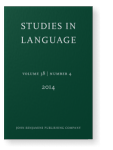Transferability of semantic functions in contact-induced grammaticalization
The case of Singapore Colloquial English one
Unlike Standard English, one in Singapore Colloquial English (SCE) not only functions as a numeral and a pronoun, it also functions as a nominalizer and a contrastive focus marker. Even though previous studies on SCE one have unequivocally proven that the expanded functions of one were a result of Chinese influence, few have provided an explanation for the non-transferability of the nominal modification marker function. Based on Heine & Kuteva’s (2005) theory that contact-induced grammaticalization conforms to the principles of grammaticalization, this paper argues that an alternative reason why certain functions of Chinese de were not transferred into SCE is due to an absence of ambiguous or bridging contexts, which are mediating conditions for grammaticalization to take place. A detailed analysis of Chinese and English data clearly demonstrates how similarities between one and de create ambiguity in the input of SCE, thereby allowing one to grammaticalize via the mediation of bridging contexts.
References
Alsagoff, Lubna & Ho Chee Lick
1998 The relative clause in colloquial Singapore English.
World Englishes 17(2). 127–38.


Anderson, R.W
1983 Transfer to somewhere. In
Susan Gass &
Larry Selinker (eds.),
Language transfer in language learning, 177–201. Rowley, MA: Newbury House.

Ansaldo, Umberto
2009 Contact Languages: Ecology and Evolution in Asia. New York: Cambridge University Press.


Bao, Zhiming
2005 The aspectual system of Singapore English and the systemic substratist explanation.
Journal of Linguistics 41(2). 237–267.


Bao, Zhiming
2012 Substratum transfer targets grammatical system.
Journal of Linguistics 48(2). 479–482.


Brown, Adam
1999 Singapore English in a nutshell: An alphabetical description of its features. Singapore: Federal Publications.

Bybee, Joan
2003 Cognitive processes in grammaticalization. In
M. Tomasello (ed.),
The New Psychology of Language, Vol.21, 145–167. New Jersey: Lawrence Erlbaum Associates Inc.

Chen, Ping
2009 Aspects of referentiality.
Journal of Pragmatics 41(8). 1657–1674.


Ellis, Rod
2008 The study of second language acquisition, 2nd edn. Oxford: Oxford University Press.

Gupta, Anthea Fraser
1992 Contact features of Singapore colloquial English. In
Kingsley Bolton &
Helen Kwok (eds.),
Sociolinguistics today: International perspectives, 323–345. London: Routledge.

Gupta, Anthea Fraser
1994 The step-tongue children’s English in Singapore. Clevedon, England: Multilingual Matters.

Heine, Bernd & Tania Kuteva
2005 Language contact and grammatical change. Cambridge, UK: Cambridge University Press.


Himmelmann, Nikolaus P
2004 Lexicalization and grammaticization: Opposite or orthogonal?. In
Walter Bisang,
Nikolaus P. Himmelmann &
Björn Wiemer (eds.),
What Makes Grammaticalization? A Look from its Fringes and its Components [
Trends in Linguistics, Studies and Monographs 158], 21–42. Berlin: Mouton de Gruyter.

Hole, D
2011 The deconstruction of Chinese shì...de clefts revisited.
Lingua 121(11). 1707‐1733.


Hopper, Paul J. & Elizabeth Closs Traugott
2003 Grammaticalization. 2nd edn. Cambridge, England: Cambridge University Press.


Kellerman, Eric
1977 Towards a characterization of the strategies of transfer in second language learning.
Interlanguage Studies Bulletin 21. 58–145.

Kiss, Katalin E
1998 Identificational focus versus information focus.
Language 74(2). 245–273.


Li, Charles N. & Sandra A. Thompson
1981 Mandarin Chinese: A functional reference grammar. Berkeley: University of California Press.

Lim, Lisa
2007 Mergers and Acquisitions: On the ages and origins of Singapore English particles.
World Englishes 26(4). 446–473.


Lü, Shuxiang
1980 Xiandai hanyu babai ci [
Eight hundred words in Modern Chinese]. Beijing: The Commercial Press.

Müller, Natascha
1998 Transfer in bilingual first language acquisition.
Bilingualism: Language and Cognition 1(3). 151–71.


Odlin, T
1989 Language transfer: Cross-linguistic influence in language learning. Cambridge, UK: Cambridge University Press.


Paul, Waltraud & John Whitman
2008 shì...de focus clefts in Mandarin Chinese.
Linguistic Review 25(3). 413–451.

Ringbom, H
2007 The importance of cross-linguistic similarity in foreign language learning: Comprehension, learning and production. Clevedon, UK: Multilingual Matters.

Selinker, Larry
1992 Rediscovering interlanguage. London: Longman.

Siegel J
2012 Constraints on substrate transfer revisited.
Journal of Linguistics 48(2). 473–478.


Stark, Elisabeth & Natascha Pomino
Su, Zhengjie
2010 Jie gou zhu ci ‘de’ de yu fa hua li cheng [On the grammaticalization of the structural particle ‘de’].
Hanyu Xuebao [
Chinese Linguistics] 29(1). 23–35.

Szabolcsi, Anna
1981 The semantics of topic-focus articulation. In
J.A.G. Groenendijk,
T.M.V. Janssen &
M.J.B. Stokhof (eds.),
Formal methods in the study of language, 513–540. Amsterdam: Mathematisch Centrum.

The British National Corpus
, version 3 (BNC XML Edition)
2007 Distributed by Oxford University Computing Services on behalf of the BNC Consortium.
[URL] (15 Aug, 2013).
Thomason, Sarah Grey & Terrence Kaufman
1988 Language contact, creolization, and genetic linguistics. Berkeley: University of California Press.

Traugott, E.C. & G. Trousdale
Wee, Lionel & Umberto Ansaldo
2004 Nouns and noun phrases. In
Lisa Lim (ed.),
Singapore English: A grammatical description, 57–74, Amsterdam: John Benjamins Publishing Company.


Weinreich, Uriel
1953 Languages in contact, findings and problems. New York: Linguistic Circle of New York.

Winford, Donald
2003 An introduction to contact linguistics. Malden, Mass: Blackwell Publishing.

Wode, Henning
1978 The L1 vs L2 acquisition of English negation.
Working Papers in Bilingualism 151. 37–57.

Wong, Jock
2005 Why you so Singlish one? A semantic and cultural interpretation of the Singapore English particle one.
Language in Society 34(2). 239–275.


Xu, Liejiong
2002 Hanyu shi huati jiegouhua yuyan ma? [Is Chinese a topic-structuralized language?].
Zhongguo Yuwen [
Studies of the Chinese Language] 51. 400–410.

Yip, V. & S. Matthews
2007 The bilingual child: Early development and language contact. Cambridge, UK: Cambridge University Press.


Zhan, Fangqiong & Sun Chaofen
2013 A copula analysis of shì in the Chinese cleft construction.
Language and Linguistics 14(4). 755–789.

Cited by
Cited by 1 other publications
This list is based on CrossRef data as of 14 april 2024. Please note that it may not be complete. Sources presented here have been supplied by the respective publishers.
Any errors therein should be reported to them.
